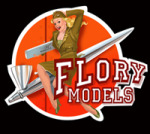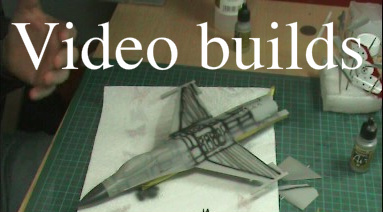Ross Amstrongs A-7 Corsair II
The Kit Box and Sprue layout
(BTW does anybody know what a "USS" A-7E Corsair II is?) 
This is the most securely packed kit I have come across so far. Styrofoam to protect the canopy rails, bubble wrap around some of the smaller sprue pieces, clear parts and metal gear in a separate box. Well done Trumpeter ! 




There are a TON of weapons for this kit. I certainly won't be using them all so if you ever need a 1/32 scale piece of ordanance, let me know!





The kit came with both plastic and metal gear, rubber tires and a fret of PE. These were all packed securely in a separate box!
Large sheet of full color painting and decal guide for both the aircraft and the weapons.

Decals for two different aircraft and a separate sheet for all the weapons.

For markings for VA-66. I'll be using AirDOC decals and the lo-vis paint scheme. I'll be using primarily LifeColor paints with Vallejo and Tamiya mixed in where needed.
I get a chance to play with lots of extra bits including the Aires resin cockpit, Eduard Exterior PE and Canopy Masks and my first use of Seamless Suckers resin intake and exhaust.


This Aires cockpit is just crammed with detail. Take a look at this closeup. They have even provided the manuals!! 

Three frets of PE in the Eduard set including some color items.
I've been back into modeling almost a year and have several builds under my belt and was feeling pretty comfortable.
But I must admit, I'm feeling a bit intimidated by this kit at the moment.
I think I'll start off by just spending a while looking at all the instructions of the different parts, making notes where needed and browsing the web for reference material.
I've been looking forward to this kit for a while and I think it will be a really fun build.
Well, I knew I was going to have to do a whole lot of dry fitting and sanding before any actual construction could begin.
So I started by removing all the excess resin from the castings.
Followed this by several hours of sanding and holding the pieces up the light (to prevent sanding too far) and I must admit that I am not too happy with the fit of the Seamless intake.
Now obviously the fuselage is just taped together and actually gluing the piece in place would take a lot of CA glue and squeezing and clamping like many aftermarket parts. But I kept looking at how "squashed" the intake looked.
I kept going back to the Zactomodels website Weebles (Dave) suggested and looking at the difference between a "squashed" inlet and a "normal" inlet (as well as the canopy) and finally hit the "Add to Cart" button. (Thanks a lot Dave!)
Hopefully they ship Fedex and it gets here soon! 
In the meantime I went ahead and worked on the equipment bays and wheel wells. The kit already has a lot of tubing detail, so I only added a couple of extra pieces.

While waiting for my new parts to come, I spent the last couple of evenings working on the ordnance. This kit comes with so much stuff, but fortunately the pilot I'm building it for only wants two triple ejector racks filled with MK82 snake eyes, 1 - AIM 9, and 1 - external fuel tank. So I will have plenty of 1/32 weapons left over if anybody needs them. 
Boring stuff so I didn't bother taking photos. I did get to use my Flexi-i-file for the first time and I love it. Really made sanding the round bombs easy. I will post a photo later in case someone hasn't it seen it posted in a couple of other build threads.
Well the parts came today and they are simply a work of art. If you haven't browsed over to Zactomodels - you should - especially if you are planning a 1/32 MIG-29 or SU-27. I mean it - you can come back and finish my boring old update later! 
The parts were securely (and uniquely) packed. These are the canopy rails glued to the bottom of a cup - clever.
The engine intake goes all the way to front of the engine and is molded in a gloss white resin so I don't even plan to paint it. It also is designed to match up with the kit connecting points (unlike the Seamless Suckers which had no attach points)
They must have known I have never worked with a vacuform canopy before so they included an extra one for when I screw up the first one! It also includes an additional inlet in case you used the kit inlet (I had order the combo inlet/canopy set).
Here's a close up of the inside front canopy rail (before any cleanup). You can see the wire running up the trouble lights!

First step was to cut off the existing nose. I used a piece of Dymo tape to help ensure a straight line with my P cutter. Since it was such a short cut and since I had to cut around the air refueling probe on the opposite side, I decided not to use the saw.
Luckily I stopped myself before I made the first scribe. I laid the Dymo tape on the wrong side of the cut. All the material that would be removed with the P cutter (all .05mm of it) would have come out of the material I wanted to remain instead of the material I was removing.
SO I flipped the Dymo tape over to the opposite side of the planned cut.
And removed the nose. Whew! That mistake could have affected the fit of the cockpit and the canopy.
The fit of these parts is so good that it only took a couple of minutes of sanding and dry fitting to get everything to line up.
I roughly cut out the canopy to make it easier to make the final cuts. Even with semi-flexible vacuform parts, I filled it with clay to help prevent cracking. Dymo tape, a fresh blade and a really bright light help me cut out the canopy. I used very light pressure and let the blade do the work. It probably took me twenty passes on each section before the blade worked its way completely through.
Here's another close up of the great detail on the front canopy rail.
A bit of light sanding to clean up the edges and the canopies were dry fit into place. The front canopy rail actually glues onto the cockpit top rail and the clear canopy itself attaches to the fuselage. The rear canopy affixes to the rear canopy rail which I plan to place in the open position.
I double dipped the canopies in Future and plan to let them sit for 2 weeks before touching them again (on advice from a member of my club - who just won several awards at the Nationals so I guess he knows something!)
Started work on cockpit. Painted the clear acetate instruments a mix of white, grey and clear green depending on the gauge. The PE panel was painted black and drybrushed and the knobs picked out in grey.
I tried something new (to me anyway) and that was painting the rectangular switchlights or "troubles lights" with clear orange. I was hoping to replicate the slight gloss look and orange color that modern cockpits look like with all the lit from behind switches and warning lights. Most of these are located in the upper left corner of the IP and all along the upper edge of the glareshield. It's not perfect, but it turned out better than I expected.
Used the same technique on the side consoles and followed everything with a light application of the Promodeller's light dirt wash to give it that "dusty" look.

It took 16 pieces of PE to make the seat belts, but they match the real thing so hats off to Aires!
Used Alclads to create the heat distorted look of the tail pipe. Used Pale Burnt Metal as the base color and progressively applied Hot Sepia, Red, Blue and Violet towards the end of the nozzle. Tried to blend in all the color rings with a light overspray of the Hot Sepia.
Next, I glued the gun and the equipment bays and wheel wells to the fuselage halves. No problems as the fit was very good.

Finally, the tailpipe was glued in.
Here's a look down the looonngg intake to the turbine blades.
Here is how long it goes through the fuselage. About three time longer than the kit piece. And it was very nicely cast.
The cockpit tub is dryfit at the moment and looks like it should fit nicely.
Well, with the fuselage halves dryfit, the cockpit sat a bit low. Since I didn't plan to glue it into its final spot until after the fuselage halves were glued together, I needed a way to raise it up and still allow for final adjustments.
So I glued a couple of strips cut from a makeup sponge (which I usually cut to fill intakes and wheel wells, etc.) to glue to the bottom. This would allow me raise it up but it is flexible/compressable enough to allow me to make final adjustments before gluing into place.
Here it is dryfit back into place again. Much better fit this time.
It took a couple of hours of final sanding and dry fitting to get all the different parts involved to line up correctly. But I would much rather spend the extra time up front making it fit as best I can rather than filling, sanding and rescribing. I will still have some of that, but hopefully not a much.
I am really happy with the look of the correct nose and inlet shape. Combined with the corrected canopy, and the Zactomodel parts were a tremendous improvement to the original kit.
I finish this update with a couple shots of the nose section all finished and glued into place.


The kit is really geared towards building it with the wingtip in the folded postition as there are several nicely detailed parts of the wing fold. However, the person I'm building it for doesn't want them folded. There is not a lot of surface area to join the wingtips in the down position and still provide much strength. So I glued some plasticard to the inside of the fold joints in hopes of making it stronger. If I could do it over, I would attach the wing tip top to the wing top first so I could cut in room for longer and thicker pieces of plasticard from left to right instead of front to back. Then I would have glued the complete top and bottom wing part together. Hopefully it will be a strong enough joint the way I have already done it.
Here is the wing glued to the fuselage. I have also temporarily attached the original rear canopy to close off the cockpit for painting since the canopy rail details of the aftermarket parts prevent it from closing flush. This will protect the cockpit during the paint process without having to mask it off.
The wing fit nicely and the joint lines match with panel lines so it will only take minor filling and sanding to cleanup the joint.
Got some work on the ordnance and pylons done. I wanted to get the rough look that many of the MK82s have so I used a very rough grit sand paper in my flex-i-file. Hopefully it will stay rough looking after it is painted.
Trumpeter put lots of nice detail on the pylons too.
The kit including optional metal gear struts. Unfortunately, due to Trumpeter's poor quality control, I received two left gears for a couple of the parts and had to mix in some of the original plastic piece  . Even so, the pieces all fit well and have good detail.
. Even so, the pieces all fit well and have good detail.
The parts were sprayed with Lifecolor LC51 gloss white and given a black ink pin wash. The Eduard set included some nice color PE placards to dress up the gear.
I'll have to go back through some of the reference photos I'm using to see what kind of brake/hydraulic line details can be added to dress them up with some scratch build detail.
The kit comes with rubber tires, so it was easy to paint up and weather the wheels. Hopefully, trying to get the rubber tires on won't damage the paint!
One thing that just popped into my skull is I could try using the Archer transfers antiskid texture decal. Depending on how well I can shape it around the nose it might work.
Not only were there a lot of great models there, but I got the opportunity to act as a judge. Tougher than I thought but I learned a lot from the other judges and was amazed to see how many times it was just the simple things that set one build apart from another. An exposed seam here, a blob of filler there.
On many of my builds, this one included, I often find myself rushing towards the finish line to get it done. And, perhaps accepting some of the same similar faults that showed up at the model show.
So anyway, besides having a great time with Lloyd and his fellow club members, I came away with a renewed attitude towards the simple things in the building process. Although I had been anxious to get this Corsair primed so I could move on to the painting. I forced myself to spend the time necessary to go over all parts of the model looking for those same types of flaws that are so easily removed with just a little bit of extra work. Hopefully it will pay off in the end.
First off, I had to say goodbye the equipment bays. The person I'm building this for wants them closed. So here are the last parting shots.

It did take a few hours of filling and sanding to fix all the little flaws both on the aircraft and all the pylons and weapons (especially the pylons and weapons!) 
In addition, the owner wants both the flaps and slats in the fully retracted position and no aileron droop so it will have a nice clean wing.

I cleaned all the parts with Testors Plastic Model Prep and then sprayed it with Mr. Surfacer 1200 from the spray can. And then hung it up to dry (this one is too big to hang in my popcorn machine  )
)

I really like how well the Mr. Surfacer fills in the sanding marks and leaves a smooth hard finish. It is tough too. A single coat of Lifecolor is easily rubbed or scratched back down to the plastic. The Mr. Surfacer primer really gives it something to grab onto.
In the first two photos, you can really see the shape difference between the aftermarket front canopy and the original kit rear canopy (I am using the kit rear canopy to cover the cockpit during painting)

Fortunately, no need to drill out the rivets on this kit!

Here's a couple of close ups of the TER and Pylons.

Started painting the Mk82 snakeyes. I sprayed the main bomb casing with UA222 faded olive drab and the fins with UA004 olive drab. Here I've masked them to get ready to spray the yellow ring around the nose signifying live ordnance.
I think I may respray the tails to get a bit darker as it looks like it is all the same.
I used Alclad Duraluminum for the fuse body and Pale Burnt Metal for the spinner. You can still see a hint of the texture on the bomb casing from the rough sanding showing through. 
put on the decal and gave them a coat of Lifecolor flat. They still looked a little boring so I tried to copy the look of the arming wire and fin retaining ring by breaking out my tiny drills and smallest gauge wire.
This turned out to be a lot easier than I thought. The wire is terminated into small holes that are hidden by the bomb shackle. It is held in place with a drop of gator glue. Hopefully it will be just a subtle detail when there are 9 hanging off the TER. If it is too much, it is easily removed.
I first used Lifecolor UA027 Dark Compass Grey for the base color. Then added a few drops of white to the mix for post shading.
I next tried to replicate wear and tear by spraying UA026 Light Compass Grey on random panels and sections of panel lines to simulate field paint repairs.
Finally finished with a coat of Future over the model.


I let the Future dry for over 24 hours before applying decals. Not a whole lot of stencils so this phase went rather quickly. After giving the Micro Sol a couple of hours to fully dry, I brushed a protective coat of Future over the decals.


While that was drying, I applied the Promodellers Dark Dirt to the parts with no decals.
After the Future had dried over the decals for a few hours, I finished today's work by applying the wash to airplane.
All the handling resulted in a seam crack appearing right along the spine of the fuselage.
So I thought, hey no big deal. I make the repair and if the paint doesn't match perfect, it will just be more of the highly worn field repair and paint look I was after anyway.
So I masked it off to work on. Sanded it down, reprimed and painted and even put the coat of future back on.
And then disaster struck. I
While removing the masking, the right side RESCUE arrow started to come up with the tape - even though there was a coat of Future over it. In an attempt to break the bond, I thought I would dab it with a bit of Micro Sol. Well, I almost saved it but I was too slow. It was a mistake to use the Micro Sol because, although it broke the bond of the tape, the decal shriveled up before I could lay it back down flat. Not having a spare, I simply decided to remove the entire thing.
But that wasn't all. Tonight when I was affixing all the little exterior pieces, I noticed a section of the WARNING decal was missing. Again, I don't have a spare, but this is such a major one I decided to leave it as these are actually large vinyl stickers anyway and ofter peel off. Hopefully the guy I'm building it for doesn't mind. If he does, looks like I get to buy another set of decals. Another lesson learned.
Anyway, here's a shot of the undercarriage.
she's all finished.
Despite the design flaws, this Trumpeter kit had a lot of detail and went together without major difficulty. I can't say enough great things about the Zacto model parts. They look great and fit perfect. I really loved the Aires cockpit as well.
As always some mistakes were made along the way and many things were learned. The proverbial "perfect build" will just have to wait until the next one! 
Thanks for watching and for your comments.
Here's a parting photo. All the shots are in the completed gallery here.










